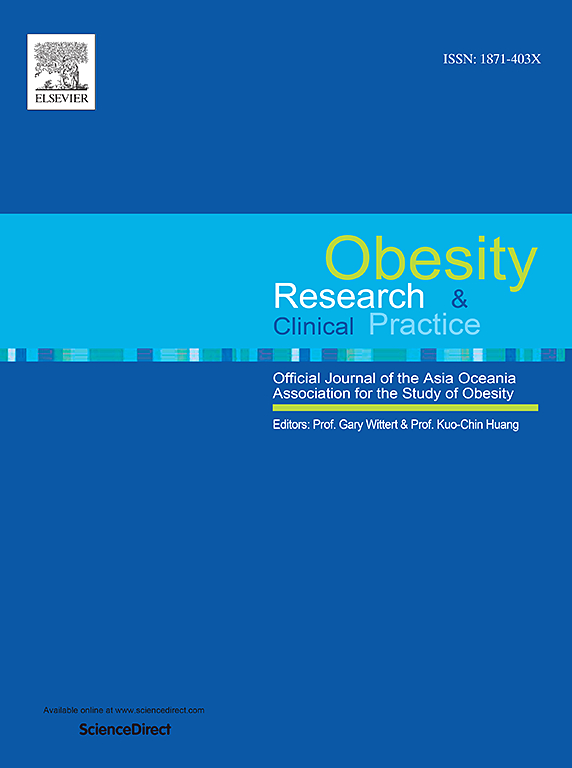Association of different obesity indices with nephrolithiasis in community-dwelling older adults
IF 2.5
4区 医学
Q3 ENDOCRINOLOGY & METABOLISM
引用次数: 0
Abstract
Background and objective
Obesity has been linked to various conditions, including nephrolithiasis. Given the rising prevalence of both nephrolithiasis and obesity in older adults, this study aimed to examine the association of different obesity-related indices with nephrolithiasis.
Methods
This cross-sectional study included 2419 individuals (mean age 69.34 ± 6.40; 51.92 % female) from the Bushehr Elderly Health (BEH) program, a population-based measured using Dual-energy X-ray absorptiometry (DXA), while nephrolithiasis history was assessed through medical records. The associations between obesity-related indices and nephrolithiasis were analyzed using multivariable logistic regression models, adjusted for relevant confounders.
Results
Among the 2419 participants, 212 (8.76 %) had a history of nephrolithiasis. In the overall population, only the android-to-gynoid fat mass (FM) ratio was significantly associated with nephrolithiasis (odds ratio [OR] 3.28, 95 % Confidence Interval [CI] 1.06–10.18). In females, the trunk-to-limb FM ratio (OR 2.62, 95 % CI 1.10–6.23) and the visceral adipose index (VAI) (OR 1.092, 95 % CI 1.005–1.187) were associated with nephrolithiasis. In males, only the body adipose index (BAI) was significantly associated with nephrolithiasis (OR 1.082, 95 % CI 1.017–1.151).
Conclusion
In this study, the android-to-gynoid FM ratio in the total population, the trunk-to-limb FM ratio and VAI in females, and BAI in males were significantly associated with nephrolithiasis. Monitoring and managing these indices may enhance quality of life for elderly individuals by facilitating early diagnosis of nephrolithiasis and preventing stone formation.
不同肥胖指数与社区老年人肾结石的关系。
背景和目的:肥胖与多种疾病有关,包括肾结石。鉴于肾结石和肥胖在老年人中的患病率不断上升,本研究旨在探讨不同肥胖相关指标与肾结石的关系。方法:本横断面研究纳入2419例个体(平均年龄69.34±6.40;51.92%女性)来自布什尔老年健康(BEH)项目,这是一项基于人群的双能x线吸收仪(DXA)测量,同时通过医疗记录评估肾结石病史。使用多变量logistic回归模型分析肥胖相关指标与肾结石之间的关系,并对相关混杂因素进行调整。结果:在2419名参与者中,212名(8.76%)有肾结石病史。在总体人群中,只有男性与女性脂肪量(FM)比与肾结石显著相关(优势比[OR] 3.28, 95%可信区间[CI] 1.06-10.18)。在女性中,躯干与肢体的FM比值(OR 2.62, 95% CI 1.10-6.23)和内脏脂肪指数(OR 1.092, 95% CI 1.005-1.187)与肾结石相关。在男性中,只有身体脂肪指数(body adipose index, BAI)与肾结石显著相关(OR 1.082, 95% CI 1.017-1.151)。结论:在本研究中,人群中男性与女性的FM比、女性的躯干与肢体FM比、VAI、男性的BAI与肾结石有显著相关性。监测和管理这些指标可以通过促进肾结石的早期诊断和预防结石形成来提高老年人的生活质量。
本文章由计算机程序翻译,如有差异,请以英文原文为准。
求助全文
约1分钟内获得全文
求助全文
来源期刊

Obesity research & clinical practice
医学-内分泌学与代谢
CiteScore
7.10
自引率
0.00%
发文量
80
审稿时长
49 days
期刊介绍:
The aim of Obesity Research & Clinical Practice (ORCP) is to publish high quality clinical and basic research relating to the epidemiology, mechanism, complications and treatment of obesity and the complication of obesity. Studies relating to the Asia Oceania region are particularly welcome, given the increasing burden of obesity in Asia Pacific, compounded by specific regional population-based and genetic issues, and the devastating personal and economic consequences. The journal aims to expose health care practitioners, clinical researchers, basic scientists, epidemiologists, and public health officials in the region to all areas of obesity research and practice. In addition to original research the ORCP publishes reviews, patient reports, short communications, and letters to the editor (including comments on published papers). The proceedings and abstracts of the Annual Meeting of the Asia Oceania Association for the Study of Obesity is published as a supplement each year.
 求助内容:
求助内容: 应助结果提醒方式:
应助结果提醒方式:


